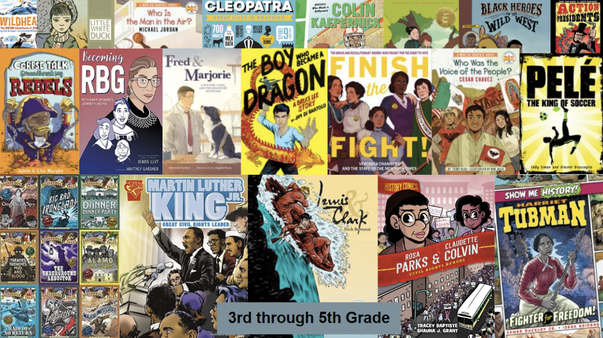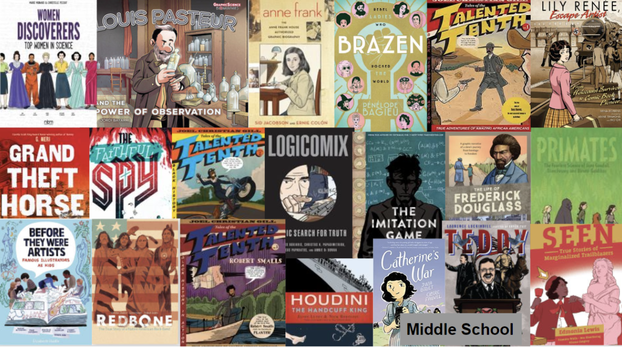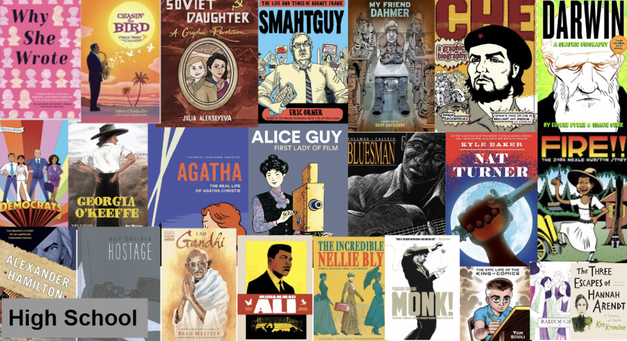- Sunbird Books “It’s Her Story” Graphic Biographies are geared towards readers aged 7 to 10. The focus is on women and their contributions to society. Rosalind Franklin, Ida B. Wells, and Shirley Chisolm are a few of the series’s subjects that are traditionally underrepresented.
- Brad Meltzer’s Ordinary People Change the World are hybrid comics and prose books featuring engaging artwork, timelines, primary source images, and thought-provoking ideas on how people can change the world for the better. Meltzer’s website also includes videos and other materials that go along with his books will inspire your students ages 8 to 12.
- Simon & Schuster’s Show Me History written by James Buckely Jr., a veteran of the Who Was? Books. Illustrated by a range of talented artists, these graphic biographies receive positive reviews for their depth of research and lighter tone that tries to bring out the positive aspects of their subjects' lives. The art and writing will definitely engage students in upper elementary and middle school, ages 8 to 12. Of the nineteen titles, a few of my favorites are the Frida Khalo, Sacagawea, and Anne Frank treatments.
- Capstone’s Graphic Library Courageous Kids Series and Graphic Lives Series are apart of their Graphic Library imprint, offering titles for grades 3 to 9, aged 9 to 15. Many of them graphic biographies. These books all receive positive reviews and cover a wide-range of people on subjects like civil rights, athletes, war, and musicians.
- Lerner Publishing Graphic Science Biographies are set apart from other more daunting STEM nonfiction by offering sophisticated language and depth in accessible ways. They currently have nine books in the series and plan to publish more. For ages 10 to 15.
- Saddleback Educational Publishing Graphic Biographies are geared toward reluctant readers. Hi-Lo books hold an important place in any genre, and though they are not rendered in my favorite art-syle, I know they appeal to many elementary and middle school students and even some high school students. They are recommended for ages 9 to 15. I appreciate the way they describe their books on their website: “Graphically illustrated biographies also teach inference skills, character development, dialogue, transitions, and drawing conclusions. Graphic biographies in the classroom provide an intervention with proven success for the struggling reader.” Indeed— their description of their books holds true for all graphic biographies.
- NBM Graphic Biographies offers wide-range of subjects— Queen, David Bowie, Alfred Hitchcock, Janis Joplin, Billie Holliday to name a few - that will appeal to high school students. Reading through many reviews of these books and sampling some of NBM’s biographies, I love that the series will showcase multiple comic artists in one volume, having each draw a different chapter. I love books like this (Explorer and Comic Squad come to mind) because they introduce students to many different comic artists in one book. The research-based approach offers a nuanced look into the person’s life and fresh perspectives on their legacy. The only negative review I saw was of their Michael Jackson book. Note: most of these biographies are found in the adult section in the Minuteman Library System. For aged 14 to 18.
Each different author and illustrator has their own spin on their story. More established writers, who practice graphic biography regularly, like Jim Ottvaniani, have worked into a particular style. Ottvaniani’s engaging, layered stories and illustrations are fantastic, and many appeal to older readers. A little younger, but still engaging and dense, are Nathan Hale’s Hazardous Tales, which focus on one part of history through the lens of a particular person’s biography. His work is so beloved, well-researched, and exciting-as-drawn, that it flies off the shelves in most libraries— elementary, middle or high school. I feel his best titles are Cold War Correspondent, Major Impossible, Lafayette, The Underground Abductor, and One Dead Spy. Adam and Lisa Murphy’s Corpse Talk series is new to me but I’ve been adding them into my library. They are set up interview style, with Adam interviewing the dead person. They are witty, thought provoking, informational, and delightful. The playful frame is definitely for the elementary and middle school reader.
Beyond reading graphic biographies for pleasure or for research, they can be used as models for student projects. During Black History Month, I’ve been working with third graders on researching a famous person involved with the civil rights movement. Students have been using prose books and taking notes on a note catcher, and then are transforming their notes into four-panel comics, practicing applying the style of story telling to their biographical data. Our slides here show some examples of the lessons and finished products.
What are your thoughts? How have you been using graphic biographies beyond having them on your shelves? What lessons can they be added to? How can you collaborate with teachers in your school to bring more graphic biographies into their classrooms? Let me know in the comments below.





